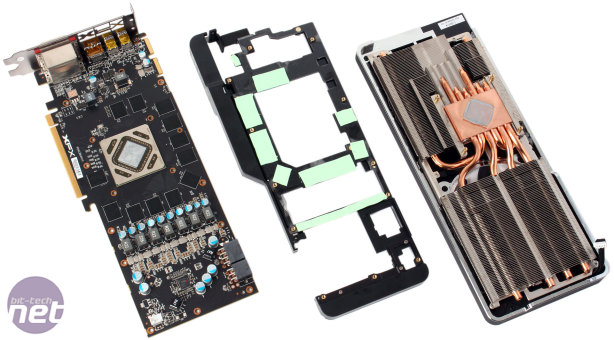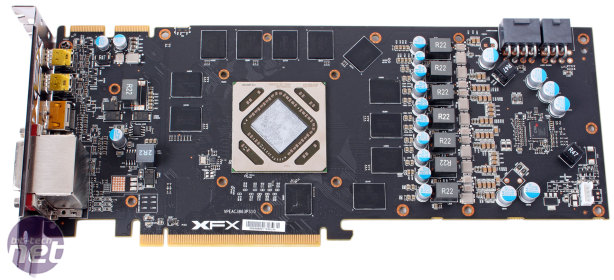Tahiti PCBs are usually 275mm long, but the XFX DD Edition card measures 282mm long in total thanks to the shroud's slight overhang. It also extends in height by about 20mm past the edge of the standard PCI bracket dimensions. This isn't likely to be an issue for most cases this isn't likely to be an issue, but small form factor users will want to be sure. Outputs include two DVI-I connections (one dual link), one HDMI and two mini DisplayPorts.
Prying off the heatsink reveals a thick copper baseplate that feeds six equally thick heat pipes and two dense fin stacks. Each fin stack is cooled by one of the two 90mm downdraft fans above – as the shroud is not sealed, some hot air from the card will escape into your chassis. XFX also provides direct cooling for the VRMs and memory chips thanks to a metal plate and some thermal pads.
The PCB carries the same design as that used in the original HD 7970 and HD 7950 cards, but it has been bulked out a little with an extra power phases that gives it a 6+1 design. This is, as usual, controlled by a CHiL 8228G controller.
The twelve 2Gb memory chips are from SK Hynix, with the product number H5GQ2H24BFR-T2C; these are rated for either 5Gbps at 1.35V or 6Gbps at 1.5V. Given that we're dealing with a desktop graphics card, we're mostly likely looking at the 6Gbps chips, in which case memory overclocking should be particularly fruitful.
Prying off the heatsink reveals a thick copper baseplate that feeds six equally thick heat pipes and two dense fin stacks. Each fin stack is cooled by one of the two 90mm downdraft fans above – as the shroud is not sealed, some hot air from the card will escape into your chassis. XFX also provides direct cooling for the VRMs and memory chips thanks to a metal plate and some thermal pads.
The PCB carries the same design as that used in the original HD 7970 and HD 7950 cards, but it has been bulked out a little with an extra power phases that gives it a 6+1 design. This is, as usual, controlled by a CHiL 8228G controller.
The twelve 2Gb memory chips are from SK Hynix, with the product number H5GQ2H24BFR-T2C; these are rated for either 5Gbps at 1.35V or 6Gbps at 1.5V. Given that we're dealing with a desktop graphics card, we're mostly likely looking at the 6Gbps chips, in which case memory overclocking should be particularly fruitful.

MSI MPG Velox 100R Chassis Review
October 14 2021 | 15:04












Want to comment? Please log in.